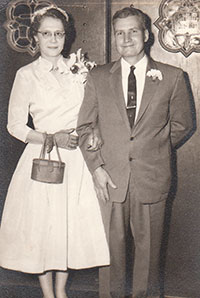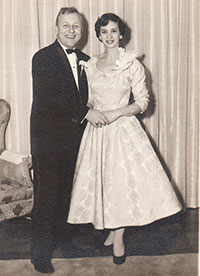 Alvira May was my paternal grandmother. With her sister Alberta, their mother Lali, and some assorted Alabama cousins, they represented the strongest repository of my early religious formation. They were Jehovah’s Witnesses.
Alvira May was my paternal grandmother. With her sister Alberta, their mother Lali, and some assorted Alabama cousins, they represented the strongest repository of my early religious formation. They were Jehovah’s Witnesses.
Their faith practice didn’t take in me; my father made sure of that, though I couldn’t say that he provided me any viable alternative. On my mom’s side were a few Catholics, some I-don’t-knows, and my grandmother – Eve – who was a Rosansky until she married my grandfather and became a Hawthorne. She claimed to be a Lutheran, but the only second language I’m remotely comfortable with is the excited Yiddish she sometimes spoke whenever we gathered for holiday feasts.
Since my early years were most influenced by my dad’s family, I spent countless hours listening to Alvira May read from Genesis. Truth be known, I got sick of hearing about who begot whom. I thought it was the entire summary of the Bible. I know better now, but I missed a couple early decades of learning time.
So I find it amazing as I get older that I’ve reopened Genesis and now read it with a set of questing eyes, listening with my internal ear. I thank St. John Paul II for leading me to reassess what I chose to ignore for about half a century.
 Alvira May and Aubrey J. Duncan, my paternal grandparentsThere’s a lot written in summary about St. John Paul’s Theology of the Body, the 129 addresses he delivered over five years on Wednesday afternoons at the Vatican. I recently stumbled onto a good book with a synopsis of the talks, but then I found the original talks. I’ve downloaded them. Many experts orient their presentations of Theology of the Body on the husband-wife aspects that comprise much of the talks.
Alvira May and Aubrey J. Duncan, my paternal grandparentsThere’s a lot written in summary about St. John Paul’s Theology of the Body, the 129 addresses he delivered over five years on Wednesday afternoons at the Vatican. I recently stumbled onto a good book with a synopsis of the talks, but then I found the original talks. I’ve downloaded them. Many experts orient their presentations of Theology of the Body on the husband-wife aspects that comprise much of the talks.
The first quarter of the talks, though, strike me with awe. First, I have to say, is that St. John Paul had a big brain. You can tell he had been thinking about this for scores of years before he delivered these talks. They are not always easy to understand; I pore over many paragraphs several times to grasp his meaning. There’s a sense in his presentations of the conversations he and Cardinal Joseph Ratzinger (Retired Pope Benedict XVI) had through the years. With a little study, one can see the influence Cardinal Karol Wojtyla (later Pope John Paul II) had on Pope Paul VI.
What impresses me much about St. John Paul II’s talks is how disunity arrives so quick in history, and then continues. In the beginning, there was such amazing unity, such continuity during the time before we became our collective history. By the third chapter of Genesis, disunity is a hallmark of our human existence. What we had as a pure gift in the first two chapters of Genesis is unblemished unity, and it is what our Catholic journey still seeks to restore.
Adam wasn’t man-male. In the beginning, there was no delineation male-female. Adam was all of humanity. There was only one of all humanity. Adam did not see himself as male or female. Adam – the integrated singleness of humanity – learned via body experience that he had a mind, a physical presence and a will. Yet, charged by God to give all creatures their name – humanity’s first task – humanity learned by comparison that it was like none of the other creatures God had made for the world.
Through that original body and by naming the animals, Adam – original humanity – learned by the negative what he was not. Original humanity was not like any of the other creatures.
Original humanity was alone, a contiguous, unified single personhood. Adam needed something positive to evolve a sense of who humanity was rather than relying on the concept of what humanity was not.
Adam is primordial solitude. We all know a piece of that aloneness deeply at times. In Adam – original humanity – all solitude ever known throughout all time was consolidated into one creature. Even solitude had unity, a burden that the original human creature carried alone. It’s a burden Jesus picked up long centuries later, and He still yearns for us to join with Him to help diffuse that solitude.
Where the meaning of original unity today seems to diverge greatest is in the very place where God intended for it most profoundly to bind us together.
 Everett and Eve Hawthorne, my maternal grandparents“...I will make a helper suited to him,” God said in Gen 2:18.
Everett and Eve Hawthorne, my maternal grandparents“...I will make a helper suited to him,” God said in Gen 2:18.
Discuss that line with the members of your family or friends. Any unity that God had intended in His vocal self-deliberations often meets hostility when discussing that line. It has historically assumed negative connotations, specifically that Adam’s intended “helper” – Eve – is going to become Adam’s housekeeper and concubine.
St. John Paul II makes clear, however, that we can’t apply our modern linguistics to the meaning of the words recorded by ancient man. “Helper” couldn’t have possibly meant those modern negative connotations because original humanity didn’t then have experience of those concepts. God did not intend any beguilement when He said “...I will make a helper suited to him.”
What God intended, St. John Paul II paints, is that Eve will be humanity’s grand catalyst. That she is formed from Adam’s rib is not implication that she is a just a piece of original man, but rather that Eve is completely all of the same humanity God poured forth into Adam, the very fullness of the image of God donated into original humanity. She, then, is something more. From the rib, everything that Adam had done, had learned, had already given to the world in his original actions since God formed him was donated by him to her. Nothing was held back. Eve was as much Adam as Adam was as much Eve.
There was no difference in them. Separate, they were still the same complete humanity. Unity.
Adam suddenly knows himself by seeing another of himself, Eve. Her presence generated his complete understanding of personhood. Instantly, Eve is equivalent with Adam. She gives everything back to Adam as much as he donated to her. By being “another,” Eve’s very presence describes to Adam what he has been all along, but could not intuit for himself without God first offering to make for him a helper, that grand catalyst.
“This, at last, is bone of my bones, and flesh of my flesh,” Adam cries out. This is pure joy, absolute rapture that Adam speaks. It is the fullness of human unity expressed in 13 simple words. This is that exquisite, unrepeatable instant when original solitude witnessed original understanding breaking into the world.
Unfortunately, time and our pride have distorted the meaning that the ancient writers recorded about the beginning, when complete unity was comprised of two.
Alvira May would be happy if she knew I’d gone back to read Genesis, especially the first three chapters, which is also where St. John Paul II concentrates so much of his treatment in Theology of the Body. She never read much more to me than those three chapters.
It surprises me how much both my Jehovah’s Witness grandmother and a saint of the faith that so underpins my life have influenced my own understanding. Though distinctly of different faiths, to me it’s as if they both are still working together to guide me along my path.
Unity.
Aubrey Duncan is a lector at St. Patrick Cathedral in Charlotte.


